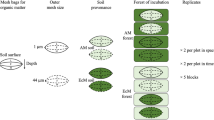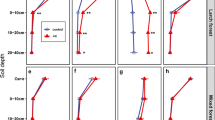Abstract
The aim of this study was to test the hypothesis that afforestation changes the content and distribution of soil organic carbon, nutrients and pH in the A-horizon of land previously used in agriculture, and that such soil changes depend on stand development. The investigation was evaluated as a completely randomised design with three treatments representing different age classes of trees: 20 years (Y20), 40 years (Y40) and 55 years (Y55). Eighteen trial plots, six per treatment, were established in plantations of Picea abies (L.) Karst. on soils of similar texture and mineralogy. Tree volume was 220 m3 ha-1 in Y20, 400 in Y40 and 440 m3 ha-1 in Y55.
Concentrations of carbon (C) and nitrogen (N) were significantly higher in the uppermost part of the soil in the older stands Y40 and Y55 than in Y20. The total amount of organic C in the litter layer plus the top 15 cm of the soil differed between age classes, with Y40 and Y55 having the largest amounts. A reference layer (15–20 cm) was used in calculating the amount of soil C that had accumulated in the horizon since afforestation, being about 10 tonnes ha-1 of C in Y20 and 19 tonnes ha-1 in Y40 and Y55.
Cation exchange capacity (CEC) and base saturation (BS) was higher in the older stands. Carbon contents and CEC were strongly correlated. In Y40 and Y55, pH was significantly lower than in Y20 in the lower part of the soil horizon. There was a general decrease with depth of C, N, CEC, K+ and Mg2+ in the soil horizon. BS, Ca2+, Na+ and pH showed a somewhat different pattern of distribution, with deceasing values in the upper part of the soil horizon and increasing values in the lower part of the soil horizon.
Similar content being viewed by others
Abbreviations
- BD:
-
Bulk density
- CEC:
-
cation exchange capacity
- BS:
-
base saturation
- Ca2+ :
-
calcium ion
- Mg2+ :
-
magnesium ion
- K+ :
-
potassium ion
- Na+ :
-
sodium ion
- C:
-
carbon
- Ca a :
-
accumulated carbon content
- C t :
-
total carbon content
- N:
-
nitrogen
- Y20:
-
age class 20 years
- Y40:
-
age class 40 years
- Y55:
-
age class 55 years
References
Adu J K and Oades J M 1978 Physical factors influencing decomposition of organic materials in soil aggregates. Soil Biol. Biochem. 10, 109–115.
Auten J T 1945 Relative influence of Sassafrass, Black locust, and Pines upon old-field soils. J. For. 43, 441–446.
Berg B 1992 Under vilka trädslag bildas humus. Skogsfakta Nr 10. SLU-Info, Swedish University of Agricultural Sciences, Uppsala. (In Swedish).
Billings W D 1938 The structure and development of old field shortleaf pine stands and certain associated physical properties of the soil. Ecol. Monogr. 8, 437–499.
Binkley D, Valentine D, Well C and Valentine U 1989 An empirical analysis of the factors contributing to 20-year decrease in soil pH in an old-field plantation of loblolly pine. Biogeochem. 7, 139–154.
Binkley D and Valentine D 1991 Fifty-year biogeochemical effects of green ash, white pine and Norway spruce in a replicated experimen. For. Ecol. Manage. 40,13–25.
Broadfoot W M 1951 Soil rehabilitation under eastern Red cedar and Loblolly pine. J. For. 49, 780–781.
Br»kenhielm S 1977 Vegetation dynamics of afforested farmland in a district of South-Eastern Sweden. Acta Phytogeographica Suecia 63, Uppsala.
Challinor D 1968 Alteration of surface soil characteristics by four tree species. Ecol. 49, 286–290.
Coile T S 1940 Soil changes associated with Loblolly pine succession on abandoned agricultural land of the Piedmont plateau. Duke University School of Forestry Bulletin 5, Durham, NC.
Craswell E T and Waring S A 1972 Effect of grinding on the decomposition of soil organic matter. II. Oxygen uptake and nitrogen mineralization in virgin and cultivated cracking clay soils. Soil Biol. Biochem. 4, 435–442.
FAO-Unesco 1989 Soil Map of the World. Technical paper 20, ISRIC, Wageningen.
France E A, Binkley D and Valentine D 1989 Soil chemistry changes after 27 years under four tree species in southern Ontario. Can. J. For. Res. 19, 1648–1650.
Hallbäcken L and Popovic B 1985 Markkemiska effekter av skogsmarkskalkning. Revision av skogliga kalkningsförsök. Report PM 1880, National Swedish Environment Protection Board, Solna. 240 p. (In Swedish with English summary).
Hägglund B and Lundmark J E 1982 Handledning i Bonitering. Del 2. Diagram och tabeller. Skogsstyrelsen, Jönköping. (In Swedish).
Melkerud P-A, Olsson M T and Rosen K 1992 Geochemical Atlas of Swedish Forest Soils. Reports in Forest Ecology and Forest Soils Report 65. Department of Forest Soils, Swedish University of Agricultural Sciences, Uppsala.
Miles J 1985 The pedogenic effects of different species and vegetation types and the implications of succession. Soil Sci. 36, 571–584.
Morrison D F 1967 Multivariate Statistical Methods. pp 133–141. McGraw, Hill.
Muys B, Lust N and Granval P H 1992 Effects of grassland afforestation with different tree species on earthworm communities, litter decomposition and nutrient status. Soil Biol. Biochem. 24 (4), 1459–1466.
Olsson M T 1989 Skogsplantering p»marginaljord-miljö och ekonomi. Geografisk Tidskrift 89, 14–18 (In Swedish with English summary).
Ovington J D 1954 Studies of the development of woodland conditions under different trees. II. The forest floor. J. Ecol. 42, 71–80.
Persson J 1974 Humus balance in cultivated soil. J. Sci. Agric. Soc. Finl. 46, 247–263.
Rovira A D and Greacen E L 1957 The effect of aggregate disruption on the activity of microorganisms in the soil. Aust. J. Agric. Res. 8, 659–673.
SAS Institute Inc. 1988 SAS/STAT User's Guide, Release 6.03 Edition. Cary, NC, USA.
SMHI 1991 Meteorologi. Temperaturen och nederbrden i Sverige 1961–90. Referensnormaler, 81, Norrkping. (In Swedish).
Westling O, Hallgren Larsson E, Sjöblad K and Lövblad G 1992. Deposition och effekter av luftföroreningar i södra och mellersta Sverige. IVL Rapport B 1079, Aneboda. (In Swedish).
Whitley G M 1991 Dynamics of organic carbon and nitrogen accumulation and distribution in soils following farm woodland planting. In Advances in Soil Organic Matter Research: The Impact on Agriculture and the Environment. Ed. W SWilson. pp 285–292. The Royal Society of Chemistry, Cambridge.
Author information
Authors and Affiliations
Rights and permissions
About this article
Cite this article
Alriksson, A., Olsson, M.T. Soil changes in different age classes of Norway spruce (Picea abies (L.) Karst.) on afforested farmland. Plant Soil 168, 103–110 (1995). https://doi.org/10.1007/BF00029319
Issue Date:
DOI: https://doi.org/10.1007/BF00029319




